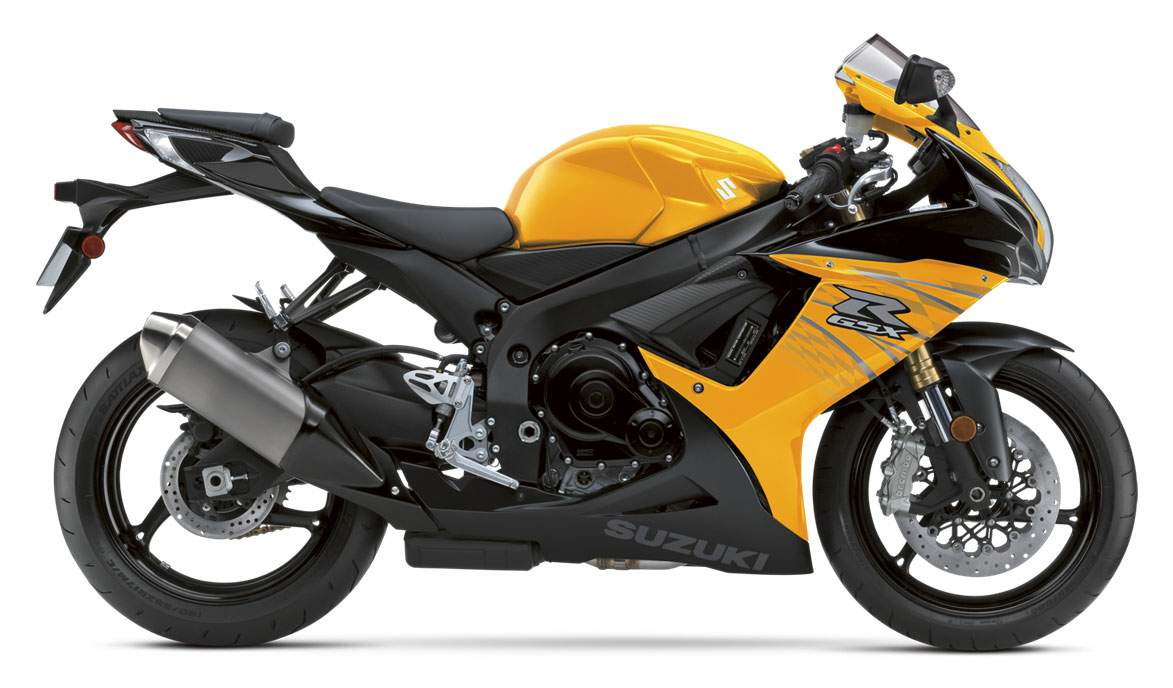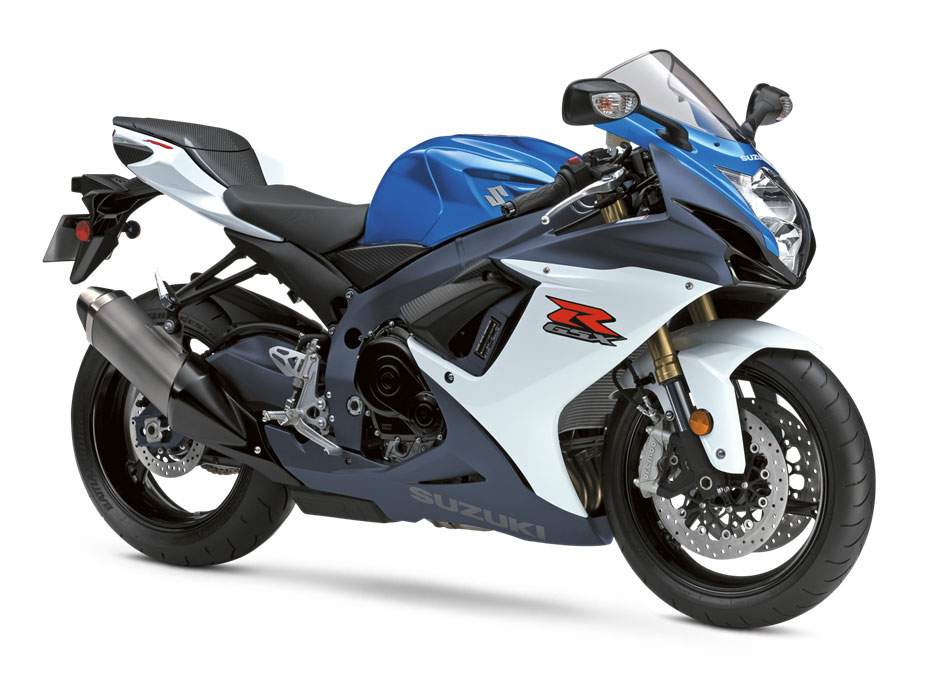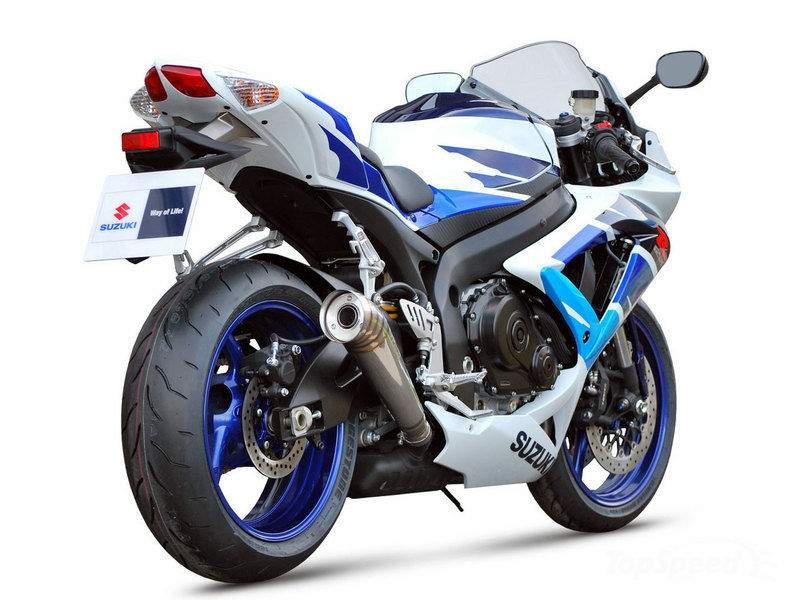2012 Suzuki Gsxr 750
Suzuki GSX-R 750

Make Model Suzuki GSX-R 750 2012 Engine Four stroke, transverse four cylinder, DOHC, 4 valves per cylinder. Capacity 749 c / 45.7 cub. in. Bore x Stroke 70 x 48.7 mm Compression Ratio 12.5:1 Cooling System Liquid. High capacity large trapezoidal-shaped radiator which includes compact cooling fan assembly designed for improved air flow. Engine Oil Synthetic,10W/40 Exhaust System Suzuki Advanced Exhaust System (SAES) with under engine muffler layout and Suzuki Exhaust Tuning (SET) system. Lubrication Wet sump Induction Ignition Spark Plug Starting Max Power 110.3 kW / 148 hp @ 12800 rpm Max Torque Clutch Transmission Front Suspension Rear Suspension Front Wheel Travel Rear Wheel Travel Front Brakes Rear Brakes Wheels Front Rim Rear Rim Front Tyre Rear Tyre Dimensions Length 2040 mm / 80.4 in. Width 715 mm / 28.5 in. Height 1125 mm / 44.6 in. Seat Height Ground Clearance Dry Weight Wet Weight Fuel Capacity Average Consumption Standing ¼ mile Standing 0 - 100 km/h / 62 mph Acc 60 - 100 km/h / 37 - 62 mph Acc 100 - 140 km/h / 62 - 87 mph Acc 140 - 180 km/h / 87 - 112 mph Top Speed
Year New 32 bit ECM features 1024 kilobytes of ROM for maximum engine performance working in conjunction with the new S-DMS engine management system Digital DC-CDI NGK, CR9E Electric 86.3 Nm / 8.8 kgf-m / 64 ft-lb @ 11200 rpm Wet, multiple discs 6 Speed, constant mesh Final Drive Chain, RK525ROZ5Y, 116 links Gear Ratios 1st 2.79 / 2nd 2.05 / 3rd 1.71 / 4th 1.50 / 5th 1.35 / 6th 1.20:1 Frame Ultra-lightweight frame built entirely of aluminum alloy castings. Showa inverted 41 mm cartridge front forks fully adjustable for high and low speed compression, spring preload, and rebound damping Showa 41mm aluminum alloy rear shock with a 16mm rod diameter are fully adjustable for high and low speed compression, spring preload and rebound damping 120 mm / 4.7 in. 130 mm / 5.1 in. 2 x 310 mm Discs, radial-mount opposed-four-piston Brembo 4 piston monoblock calipers Single 220 mm disc, Nissin single piston caliper Aluminum, 3 spoke 3.8 x 17 5.5 x 17 120/70 ZR17 180/55 ZR17 Rake 23.8° Trail 97 mm / 3.8 in. Wheelbase 1390 mm / 54.7 in. 810 mm / 31.8 in. 130 mm / 5.1 in 156 kg / 344 lbs 190 kg / 418 lbs 17 Litres / 4.5 US gal / 3.7 Imp gal 5.5 l/100 km / 18.3 km/l / 43 US mpg / 51 Imp mpg 10.7 sec 3.2 sec 4.1 sec 3.9 sec 4.5 sec 270.7 km/h / 168 mph
When you ride a GSX-R750 you have the privilege of riding a legend. It's championship-winning sport bike that not only ushered in the era of racebike replicas - it's also set records that will never be broken. On the road or on the track, the GSX-R750 delivers a riding experience that is a breathtaking combination of outstanding engine performance, crisp handling, compact size and light weight.
The key to the GSX-R750's racetrack-conquering speed and agile handling is the pairing of its powerful inline four-cyclinder, 16-valve 750cc engine with the lightweight, compact chassis of a 600cc Supersport. It's a winning combination that allows any rider to experience the exhilarating rush of a middleweight AMA Supersport bike.
The GSX-R750 is available in a new Marble Daytona Yellow/Glass Sparkle Black color combination.
Suzuki GSX-R750 Features and Benefits
Engine Features
750cc 4-cylinder engine
A 750cc, four-cylinder engine with a race-proven oversquare bore/stroke ratio provides exceptionally potent, high-revving performance.
Engine utilizes forged pistons, shot-peened conrods, chrome-nitride-coated upper compression and oil control rings, and pentagonal ventilation holes for outstanding engine performance.
Lightweight titanium-alloy valves are controlled by single valve spring to reduce mechanical losses.
Class leading Suzuki Dual Throttle Valve (SDTV) fuel injection system includes fine-spray 8-hole injectors, providing improved fuel atomization contributing to more complete combustion in the cylinder.
Advanced, race-developed transistorized ignition control circuit helps maintain more precise ignition timing across the range of engine temperatures.
A 4-into-1 stainless-steel exhaust system features a titanium muffler, which carries a Suzuki Exhaust Tuning (SET) valve. The system maximizes torque and improves throttle response, especially in the low-to-mid RPM range.
Transmission Features
A six-speed close-ratio transmission features vertically staggered shafts to reduce overall engine length.
Race-proven back-torque-limiting clutch contributes to smoother downshifting and corner entry.
Suspension
Race-developed, lightweight Showa Big Piston front-Fork (BPF) delivers superb feedback and consistent performance.
A single Showa rear shock features externally adjustable rebound and compression damping, along with adjustable ride height.
Chassis Features
A lightweight and compact twin-spar aluminum cradle frame is made of five cast sections and features a cast swingarm.
An electronically controlled steering damper provides lighter steering at lower speeds and more damping force at racetrack and highway speeds.
Front brakes feature fully floating 310mm discs and radial-mounted, four-piston Brembo monoblock calipers.
Available in Metallic Triton Blue/Glass Sparkle White and new Marble Daytona Yellow/Glass Sparkle Black

Review
In 1985 Suzuki shocked the sportsbike world with the release of the GSX-R750. Derived from experienced earned through Suzuki's successful World Endurance campaigns, the GSX-R750 was the first true race replica motorcycle from a Japanese factory.
Aerodynamic, light and powerful the GSX-R was the forefather of modern motorcycling and unlike the Europeans; Suzuki proved it was possible to do it with reliability and a touch of practicality.
Throughout its 26 year lineage, the GSX-R has - apart from a short period in the early 1990s before getting back on track in 1996 - continued the 'light-is-right' philosophy of the original.
If not for the GFC delaying the introduction of the latest model, the 2011 GSX-R750 would have been released for the 2010 model year, thus marking the 25th anniversary of the model with the lightest GSX-R yet. Suzuki hasn't wasted the year extension on the development cycle; instead it has continued the final honing process to produce a stunning package for 2011, albeit a year late. This is the biggest overhaul the GSX-R has received since 2006 and this time around the 750 has not been forgotten and receives a true update that has really put it right back in the game.
With the advent of the now dominant litre-class, Suzuki is the only manufacturer to offer a machine in the traditional three-quarter-litre category, and has been since Kawasaki discontinued their long outdated ZX-7R in 2003. The GSX-R750 has continued to sell well and Suzuki's three-pronged, GSX-R 600/750/1000 line-up has worked in its favour, securing the manufacturer top spot overall on the Australian sportsbikes charts most years since, including 2009 and 2010. A middle-of-the-road option between a daunting litre-bike and a 600cc machine, the GSX-R750 is an approachable alternative for those that like to think outside the square. And at only $400 more than the also heavily revamped GSX-R600, the 750 offers a lot of extra mumbo for the moolah.
Shorter and 8kg lighter Suzuki's engineers have spent their time shaving every last gram off the machine. The frame, swingarm and exhaust the greatest beneficiaries of the under-the-knife style of diet, while the new Showa big-piston forks and revised bodywork also do their bit, enabling the GSX-R750 to sit on the scales at 190kg ready to roll with its 17 litre fuel tank full to the brim. You don't need a set of scales to feel the difference, it is immediately apparent as soon as you tilt the bike off its sidestand.
New Brembo monobloc stoppers help to lower unsprung mass, but with little to fault with the previous brakes I feel this was as much of a nod to showroom appeal as to performance. And let's face it; showroom appeal is a huge factor when it comes to buying decisions.
In profile the 55mm shorter front and 35mm shorter rear overhangs give the 2011 bike a somewhat snub nosed appearance, in comparison to the 2010 model. I also find the distinctive headlights of the outgoing model more appealing.
Looking at the details, however, the new model seriously impresses up close and has taken a number of steps forward. Beautiful fork caps and new instruments (lifted from 2010 GSX-R1000) are striking features viewed from the cockpit along with a well finished and simplified bodywork arrangement (eight less pieces in all) illustrating a heightened sense of quality and thoroughness of design. Close inspection of the side profile reveals the fewer welds in the frame along with a less fussy tank shape and much tastier titanium muffler. The streamlined indicator positioning both fore and aft follows previous GSX-R themes. The GSX-R750 rides on a 15mm shorter wheelbase (1390mm) through revised engine positioning but retains the same rake and trail figures as its predecessor.
The 2011 machine is noticeably slimmer through the middle and positions the rider closer to the controls for a more comfortable ride; surprisingly in view of the relatively low 810mm seat height, there is still plenty of legroom via adjustable footpegs. Despite my leathers somehow shrinking since last time I wore them… I was immediately comfortable on the GSX-R and could freely move around as I navigated the Northern Territory's Hidden Valley racetrack for the first time. The bars are set slightly wider than before and while I haven't had the chance to slab it up a highway yet, I suspect the 2011 Suzuki GSX-R750 is going to prove one of, if not the most, comfortable sportsbike on the road.
Throttle response was as you would expect from a GSX-R. For years the benchmark for smooth and progressive throttle application in litre-bike form, the less torque laden mannerisms of the 750cc engine fuse with that wonderful dual throttle valve and twin injector per cylinder fuel-injection to immediately forge a wonderful relationship between the rider's right hand and the 180/55 Bridgestone biting the tarmac. Further revised for the 2011 model year with new injectors operating at different angles and a redesigned airbox Suzuki is unarguably still the market leader in throttle response.
There is a dual-map selector on the bars but unless you're a fairly novice rider, or riding in particularly atrocious conditions, I can't see the need for slowing the throttle down and lowering the power output. For 2011 the system has the settings reduced from three to two, and the B mode this time around is even more extreme in its retardation than the outgoing model's C mode.
On the right handlebar is a meter display selection switch that allows the rider to cycle through the tripmeters and is also utilised for the operation of the fully functioned lap timing system.
Despite a myriad of changes to the engine to help reduce friction and rotating mass Suzuki claims no more top end power over the outgoing model. 145hp at 13,200rpm and 86Nm of torque at 11,200rpm compare favourably with the 120hp and 70Nm of torque from the GSX-R600.
What Suzuki does claim, however, is improved low and mid-range response combined with a 10% improvement in economy. At the track we never got to put the economy side of the equation to the test but it is clear that the power delivery is predictable and linear in its progression.
The exhaust valve interruption (there to satisfy the noise Nazis) is hardly felt, whereas on the GSX-R600 there is a noticeable step up in power as the machine broaches this mark and the valve opens completely. Not a huge factor at the track with revs kept above 8000rpm, but a very useful asset for the street with the 750 much more eager at lower rpm than any 600cc Supersport bike.
Get rid of that exhaust valve by fitting an aftermarket exhaust, with a Power Commander making the requisite mapping adjustments, and the GSX-R750 will also wail a distinctive note much different from a 600 or a 1000 while delivering meaningful gains right throughout the rev range.
Even in stock form the 750 is making more torque by 6000rpm than any 600cc Supersport bike is making at their peak, while spinning nearly double those rpm. It's not hard to see why a 750 is a much better all-rounder than a 600. 20% more power at peak, and even bigger boosts in torque at street revs, all for a 2% increase in price…
Conversely, do not for a second imagine that the 750 is halfway between a 600 and a 1000 when it comes to torque and thrills. Nothing, I repeat, nothing comes close to the sheer outrageousness of a litre class sportsbike. The 750 is of course much closer to that level of insanity than a 600, but it's still nowhere near the big-bore levels of eye-popping grunt that a modern era litre-bike dishes out at even moderate throttle openings.
For many this is also a big part of the appeal, as the 750 is almost as unthreatening as a 600 but still enjoys a useful boost in torque that makes for a more pleasurable ride on the street. In fact, I would go as far as to say that for many riders just stepping up to their full licence and craving sportsbike handling and looks, the 750 is perhaps even more suitable than a 600 due to the accessibility of its performance.
The same goes for those that have a hankering for trackdays but, like the vast majority of the sportsbike riding fraternity, lack the skill, testicular fortitude and fitness to successfully master the brutality of a litre-bike. I'll put my hand up as one of those.
On the other side of the coin, the 750 is not quite as nimble and forgiving on the track as the 600 and turns a little slower. The suspension is fully-adjustable at both ends and given more time I would raise the rear ride-height as I believe that is all that it would take to make the 750 turn as scalpel like as the 600. This is easily adjusted on the GSX-R without the removal of the rear shock by simple shim replacement.
Up front the new Showa big-piston forks are remarkably smooth in operation with small bumps virtually imperceptible. One of the claims for this new style of fork is exceptional damping performance at the start of the compression stroke. Unlike most such boasts, this was immediately apparent on the Suzuki at Hidden Valley and will prove a huge asset on the street. They also deliver wonderful, almost delicate but still precise, levels of feedback. Superb.
Racetrack riding also highlighted the street compound brake pad material used in both the 2011 GSX-R600 and 750. The brake lever needed to be adjusted out at track pace to prevent the lever coming back to the bars. They still worked brilliantly but for a more consistent lever at trackdays a pad change will be in order for serious punters.
The slipper clutch is smooth in operation and a great asset. There's nothing quite like banging down the requisite number of gears at the end of a straight and releasing the clutch instantly with no thoughts of things getting unruly at the rear. Sounds horn too!
At $16,990 plus on road costs the GSX-R750 has this time around scored all the same comprehensive updates as the GSX-R600 and also carried over the electronic steering damper and slipper clutch inherited from its immediate predecessor. While those last two items are great bonuses, it does stand out that Suzuki offers no ABS or traction control systems as options on their sportsbikes. Weight and costs the primary factors in that reasoning with Suzuki choosing to spend the money refining other areas of the machine while trying to retain affordability.
The perfect sportsbike? Perhaps, but if it is power you crave then as fantastic as the GSX-R750 is, it will never match the sheer mania of a litre-bike. Still, I wouldn't hesitate to wager that most of the riders at trackdays on litre-bikes would be lapping faster - and safer - on a GSX-R750 than on their rocketships. If you are finding the latest litre-bikes getting a little bit too much (and there is certainly no shame in that), or the 600s a little too highly strung, then the GSX-R750 may be the bike for you.
Source mcnews.com.

Source: https://www.motorcyclespecs.co.za/model/suzu/suzuki_gsxr750%2012.htm

0 Komentar